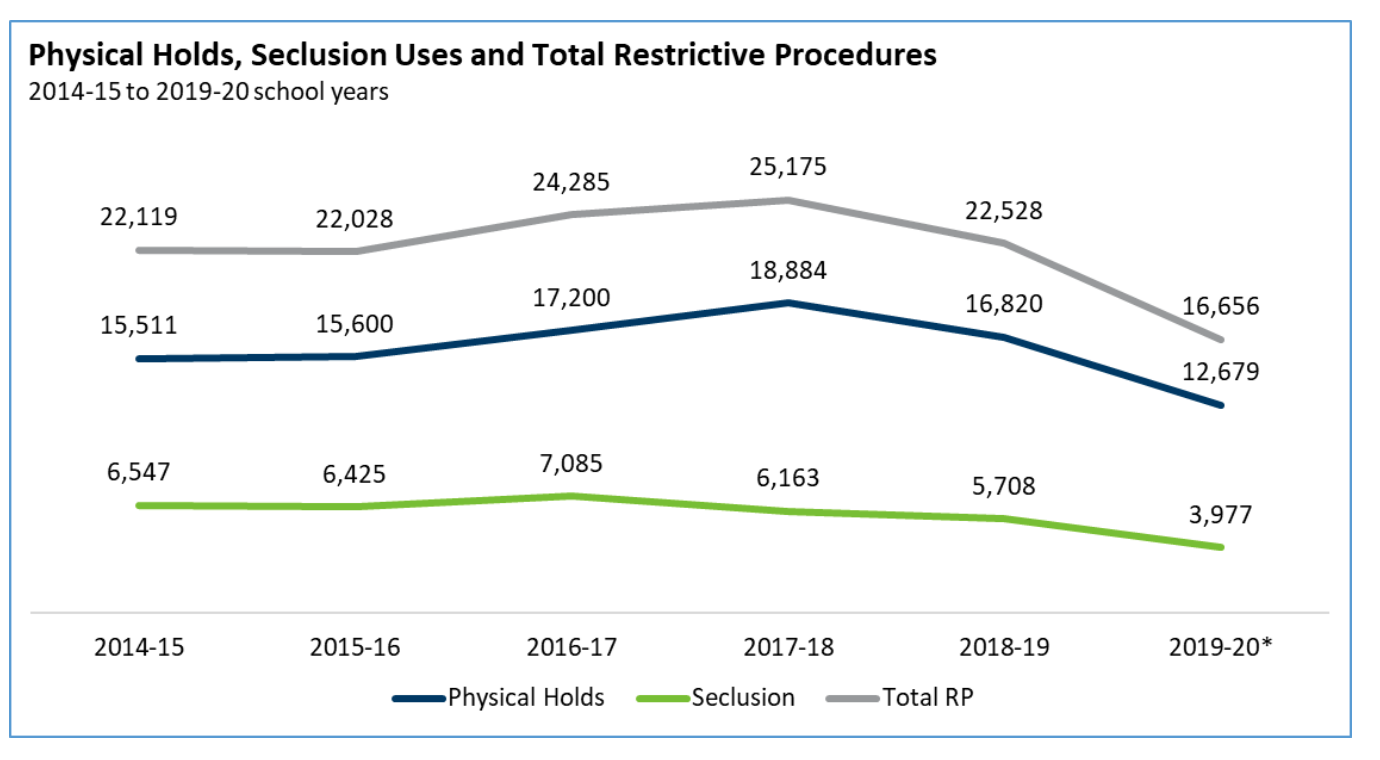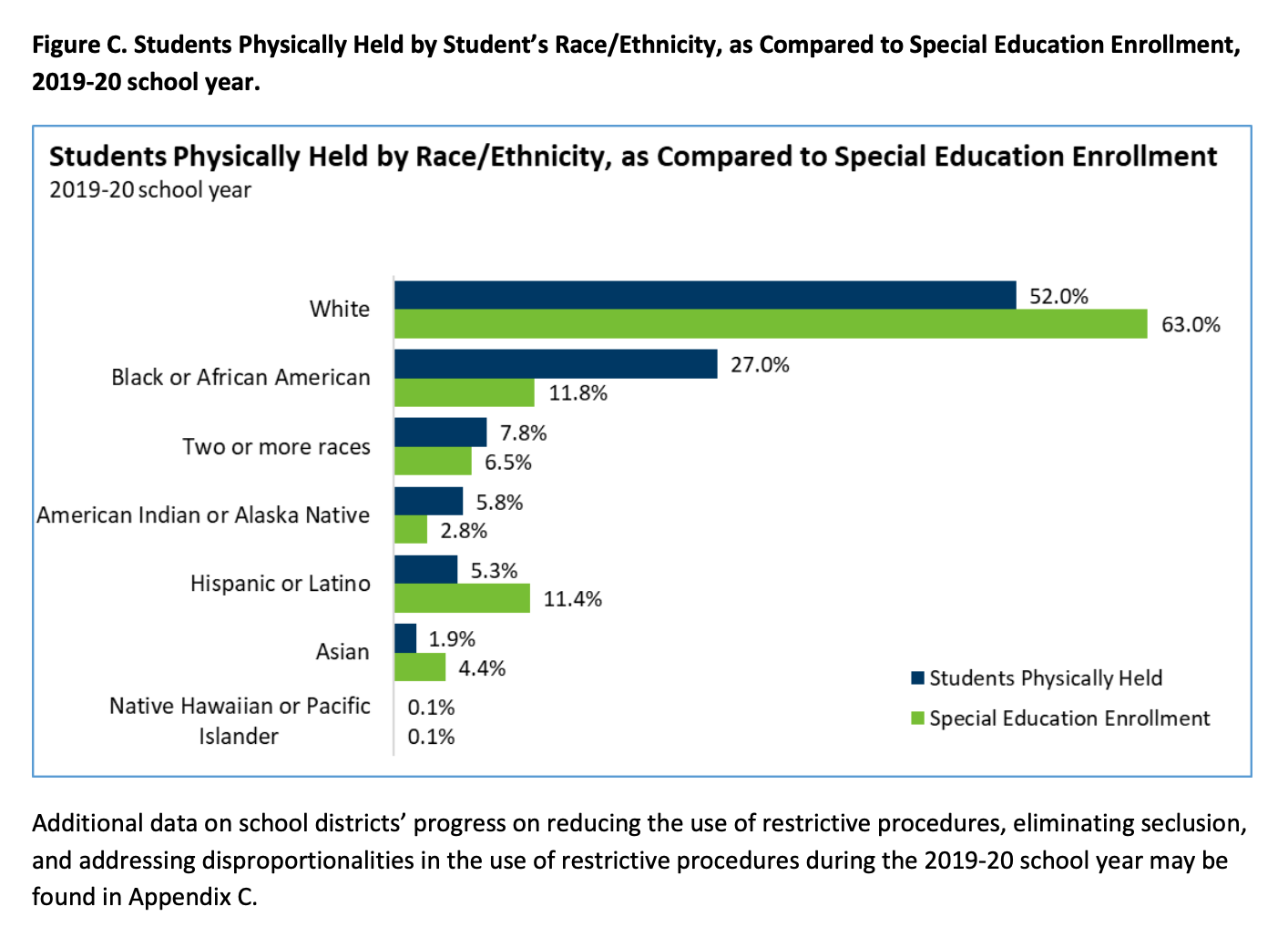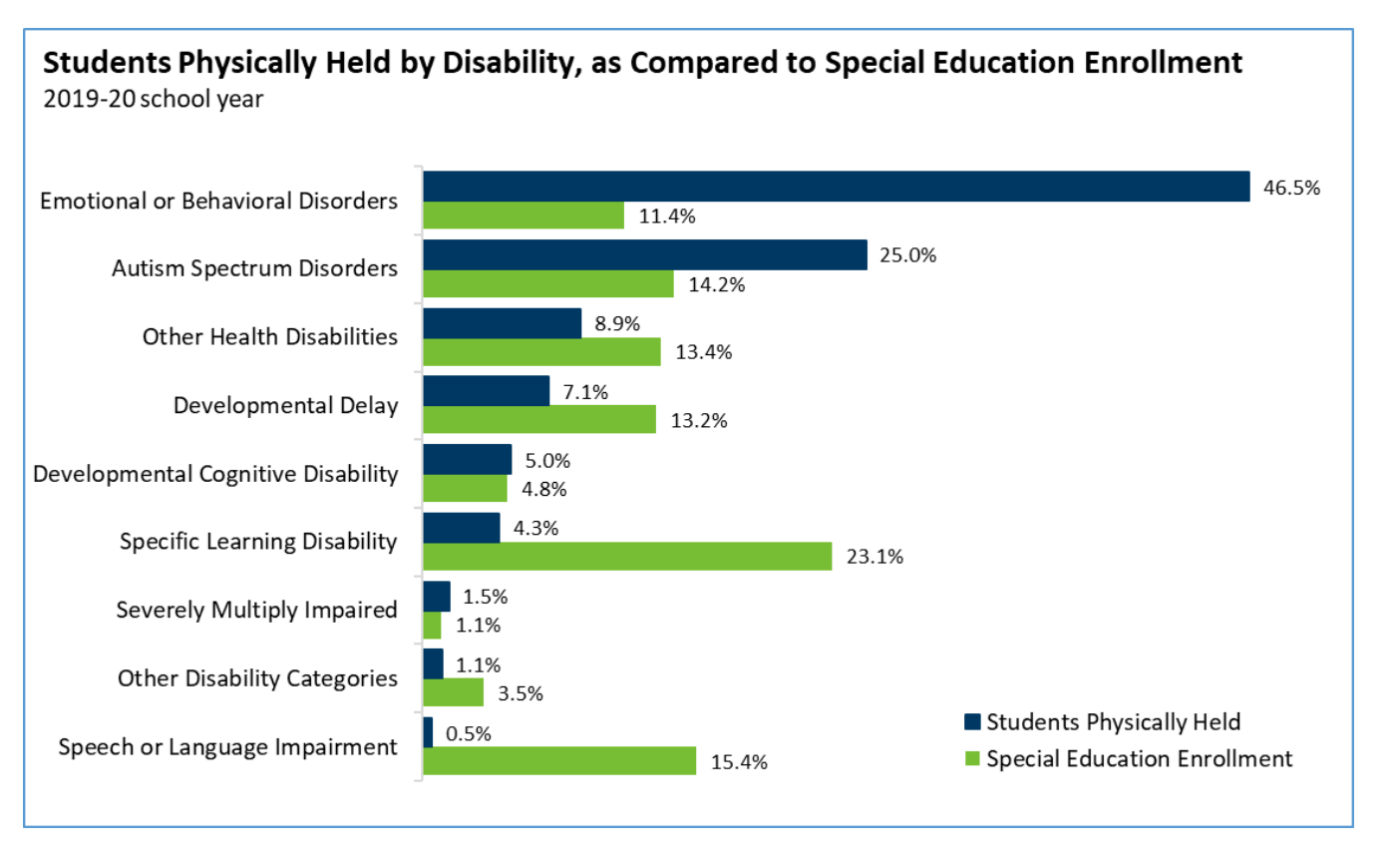George Floyd Isn’t Alone — Thousands of MN Students Are Restrained at School Each Year
By Mark Keierleber | April 20, 2021
Updated, April 21
This story is published in partnership with The Guardian
A jury found Derek Chauvin guilty of murder on Tuesday following a closely watched trial that centered on the former Minneapolis police officer’s use of physical restraint that prosecutors said killed George Floyd.
Now, the brutal manner of Floyd’s death is highlighting how the practice of restraining children with similar techniques remains commonplace in Minnesota schools — and in districts across the country.
Even though state policymakers have worked for years to reduce the prevalence of “physical holds” in Minnesota schools — including a 2015 ban on the face-to-the-ground “prone restraint” used against Floyd — educators employ the tactic thousands of times each year to subdue students, state and federal data show. Such restraints often come with devastating consequences for children including injury and, in rare cases, death.
Floyd died after being restrained for 9 minutes and 29 seconds, with shocking video of the murder spurring massive national protests and a painful, ongoing debate over police brutality, particularly against Black Americans, who are disproportionately subjected to officers’ use of force. But it also calls out the need for rules that curtail the use of restraint in schools, said Lauren Morando Rhim, co-founder and executive director of The Center for Learner Equity, a national nonprofit focused on improving educational outcomes for children with disabilities.
“We know it’s happening, we know it’s happening more than we’re aware of, and we know that children are dying as well.” —Lauren Morando Rhim, co-founder and executive director, The Center for Learner Equity
Pending state and federal legislation would place new restrictions on schools’ ability to restrain students, including a Minnesota provision that would explicitly prohibit school-based police, who are not typically district employees, from placing students in a “prone restraint,” a change officials said was a direct response to Floyd’s death. While some education leaders have long held that physical restraint is critical in dire emergency situations, critics say the practice is used as a routine discipline tool, especially against Black children, and have called for a complete ban.
Distinguishing prone restraint from other physical holds, Morando Rhim said, is “like splitting hairs.”
“Restraint is a problem across the board and we shouldn’t be surprised that we’re seeing it in schools if we’re seeing it among trained police officers that are not able to de-escalate [situations] and they end up restraining and killing people,” she said. And unlike the millions of people who watched the video of Chauvin press his knee into Floyd’s neck, the use of restraint in schools, she said, often goes under the radar.
“We know it’s happening, we know it’s happening more than we’re aware of, and we know that children are dying as well.”

Even as the pandemic shuttered schools nationwide last spring, more than 2,800 students were subjected to more than 12,600 instances of physical restraint during the 2019-20 school year, according to a recent Minnesota Department of Education report. That’s a significant 25 percent drop from the year prior, which state education officials believe is due in large part to campus closures during COVID-19, but also recent statewide efforts to reduce educators’ reliance on the practice, training them instead how to de-escalate conflicts using preventative techniques, like positive behavioral interventions and supports.
Yet the use of restraint remains far too common in Minnesota schools, said Daron Korte, the state assistant commissioner of education who oversees the office of student support services.
“Schools don’t want their staff using restrictive procedures” like physical restraint that could open them up to legal liability if a student or teacher gets injured, he said. But as state officials urge districts to reduce their use of restraint, he said it’s critical that they’re given other tools to manage student behaviors or else “they’re going to be relying on law enforcement for those interventions more often, which is the opposite of what we’re trying to accomplish here.”
Korte acknowledged that while restraint is supposed to be a last-ditch effort in emergency situations where the student is at risk of hurting themselves or others, school disruptions that fall under that umbrella are “always open to interpretation.”
Mirroring national trends that have existed for years, students of color, and Black boys in particular, are disproportionately subjected to restraint in Minnesota schools, according to state data. White students represent 63 percent of the special education population and 52 percent of those restrained, while 11.8 percent of special education students are Black but they account for 27 percent of those subjected to physical holds.

The years-long racial disparities in student restraint, Morando Rhim of The Center for Learner Equity said, highlights the fact that “racial bias and institutional racism is very real.”
“The level of comfort that we have systematically with restraining and discriminating against Black boys, in particular, is a symptom of a huge problem,” she said.
Minnesota schools are currently only required to report to state officials their use of restraint on children with disabilities, but federal education data, which includes all students, highlight how children in special education are disproportionately subjected to physical holds. Students with specific disabilities bear the brunt of such measures. Children with emotional or behavioral disorders represented 11 percent of Minnesota’s special education population last year but account for 47 percent of students subjected to restraints. Similarly, children with autism were 14 percent of the special education population, but 25 percent of those restrained.
Nationally, more than 74,000 students were subjected to physical or mechanical restraint in the 2017-18 school year, according to the most recent data from the U.S. Department of Education’s Office for Civil Rights. That year, more than 2,400 Minnesota students were subjected to more than 11,600 instances of physical restraint. Minnesota, along with Texas and a cluster of Midwestern states, including Illinois and Iowa, were among the most frequent users of the practice, according to a 2019 analysis by ProPublica and The Chicago Tribune. In a blockbuster 2019 investigation, the news organizations found that Illinois schools frequently put students, most of them with disabilities, in padded “seclusion rooms” for reasons that violate state law, like refusing to complete schoolwork or using profanity.
The data, which is self-reported by local school districts to federal education officials, is likely a significant undercount. A 2020 report by the U.S. Government Accountability Office, a nonpartisan watchdog agency, found that the Department of Education’s quality control procedures for data collection are “largely ineffective or do not exist.”
In 2019, then-Education Secretary Betsy DeVos launched an initiative to address the “possible inappropriate use” of restraint and make federal data on the matter more accurate, but disability-rights activists remain skeptical that schools have been fully transparent. The DeVos initiative came just months after a Kentucky sheriff’s office reached a $337,000 court settlement stemming from a school resource officer handcuffing two elementary school children with disabilities above the elbows.A judge ruled in 2017 that the officer had used excessive force.
Warning — The following video contains police use of force against a child:
‘There have to be consequences’
Physical restraint’s deleterious effects are clear in the Minnesota state data: 781 educators and 153 students sustained injuries last year as a direct result of the use of physical holds. Those figures, like student restraint data more broadly, are likely a significant undercount, said Sandy Lewandowski, the superintendent at Intermediate District 287 in suburban Minneapolis.
“If you’ve ever watched a fifth-grader being restrained by four or five staff, it’s traumatic to the student, it’s traumatic to the staff and it’s traumatic to any observer.” —Sandy Lewandowski, superintendent, Minneapolsis’s Intermediate District 287
The district, a cooperative of 11 school systems that serves some of the region’s most at-risk students, including those entangled in the juvenile justice system, has worked for years to reform its school discipline practices, including a 2017 decision to remove school-based police from its buildings. And while Lewandowski said that physical restraint is only used as a last resort and that officials have worked to reduce their reliance on the technique, it remains common practice. Last school year, which was interrupted by the pandemic, the district reported 991 student restraints, down from 1,179 in 2018-19 when students were in school for the full year.
In many instances, educators use physical restraints to prevent students from harming themselves and is never used as a form of discipline, Lewandowski said. The district cited one recent example where an elementary school student was restrained after punching a campus wall near an electrical outlet in an effort to electrocute himself.
In recent years, the district has only seen the special education needs of its students grow, Lewandowski said, as mental health providers turn away youth with the most significant behavioral health challenges. Such a reality has placed a significant burden on school staff to address student outbursts. But she isn’t lost to the fact that restraint can cause both emotional and physical damage.
“If you’ve ever watched a fifth-grader being restrained by four or five staff, it’s traumatic to the student, it’s traumatic to the staff and it’s traumatic to any observer,” she said, which is why the district has been working to bring its numbers down. “But we have to have partners in that work because we also can’t have a fifth-grader totally out of control, banging their head against a wall until they settle themselves down. That’s just not something we can do.”

Yet in some cases, students have died as a result of being physically restrained. In one instance in 2018, a 13-year-old boy with autism died after a teacher subjected him to a face-down prone restraint for an hour and 45 minutes at his now-defunct California school. The campus was shuttered after the incident and three school officials, including the teacher, were charged with felony involuntary manslaughter.
Similar incidents have prompted education officials to take a hard look at the practice. In 2012, non-binding guidance from the U.S. Department of Education urged districts to refrain from using physical holds unless a student is in imminent danger of harming himself or others while noting that “there is no evidence that using restraint or seclusion is effective in reducing the occurrence of the problem behaviors that frequently precipitate the use of such tactics.” Prone restraints and other moves that “restrict breathing should never be used,” due to the risk of injury and death.
That same year, a Minnesota Department of Education report noted concerns that “it is only a matter of time before a Minnesota child is seriously injured or killed while in prone restraint,” and the practice was banned in 2015.

State laws on student restraint, including the prone restraint ban, currently center on children with disabilities and “are silent” about the general student population, said Korte, the assistant education commissioner. But pending state legislation would extend the requirements, including data reporting protocols, to cover all students. It also clarifies that school-based police are prohibited from using prone restraints in schools and would prohibit all physical holds on children under the age of 5 years old.
Chris Williams, spokesman for the state teachers union Education Minnesota, said in a statement that the group is concerned about “the ongoing racial disparities that we know exist in the use of restrictive procedures,” and supports rules that prohibit prone restraint in classrooms. He said the union is lobbying the legislature for more funding that would allow schools to “train all educators, not just special education educators, on the dangers and harms” of improper student restraints and how to use alternatives, like restorative justice.
Meanwhile in Washington, pending legislation, the Keeping All Students Safe Act, would prohibit schools from using prone restraints and other procedures that restrict student breathing, and would ban other physical restraints except when necessary to protect students and staff. Officials pointed to an influx of federal education funding because of the pandemic that could be used to implement strategies to improve school climates by reinforcing positive behaviors without restraint.
Morando Rhim said the federal legislation would go a long way to keeping students safe, especially as they return to buildings after a year of remote learning with trauma accrued during the pandemic. But laws curtailing restraint will only be effective, she said, if educators follow them.
“There have to be consequences,” she said, for those who don’t. “We cannot have systems that keep reinforcing that it is OK to kill Black people.”
Lead Image: Darnella Frazier / Facebook
Get stories like these delivered straight to your inbox. Sign up for The 74 Newsletter

